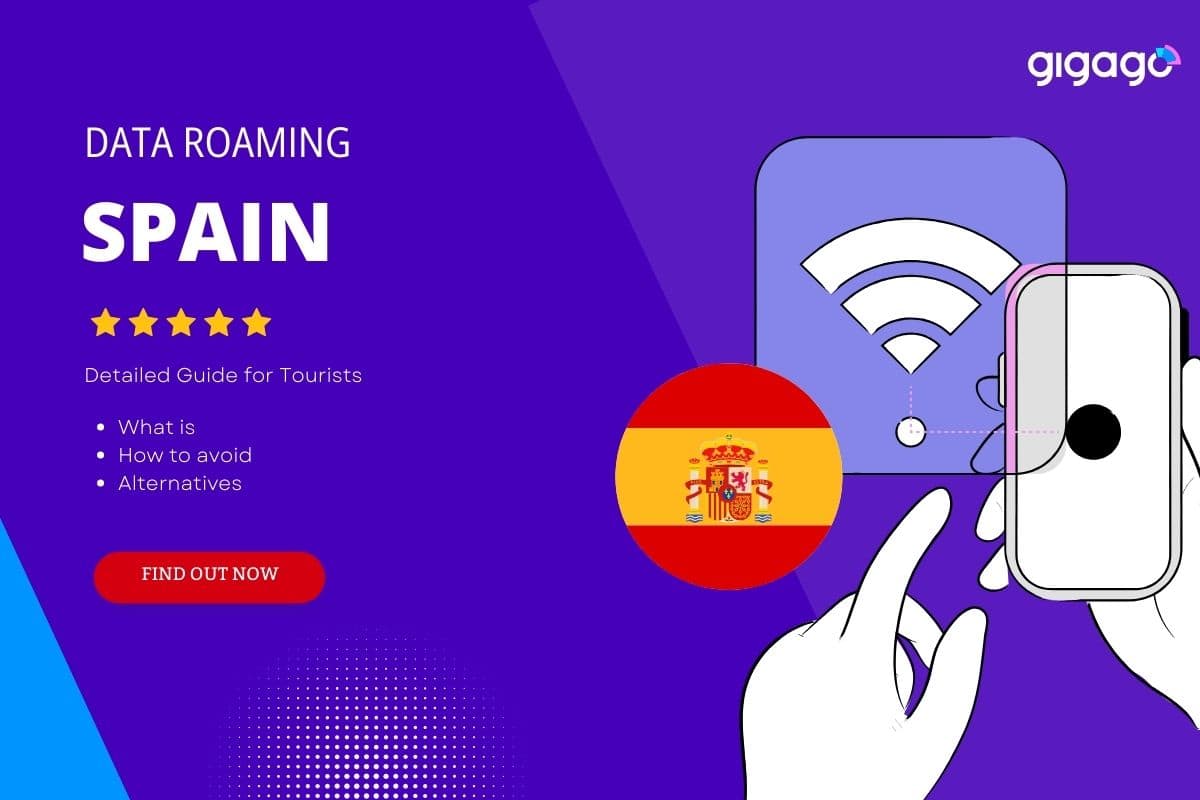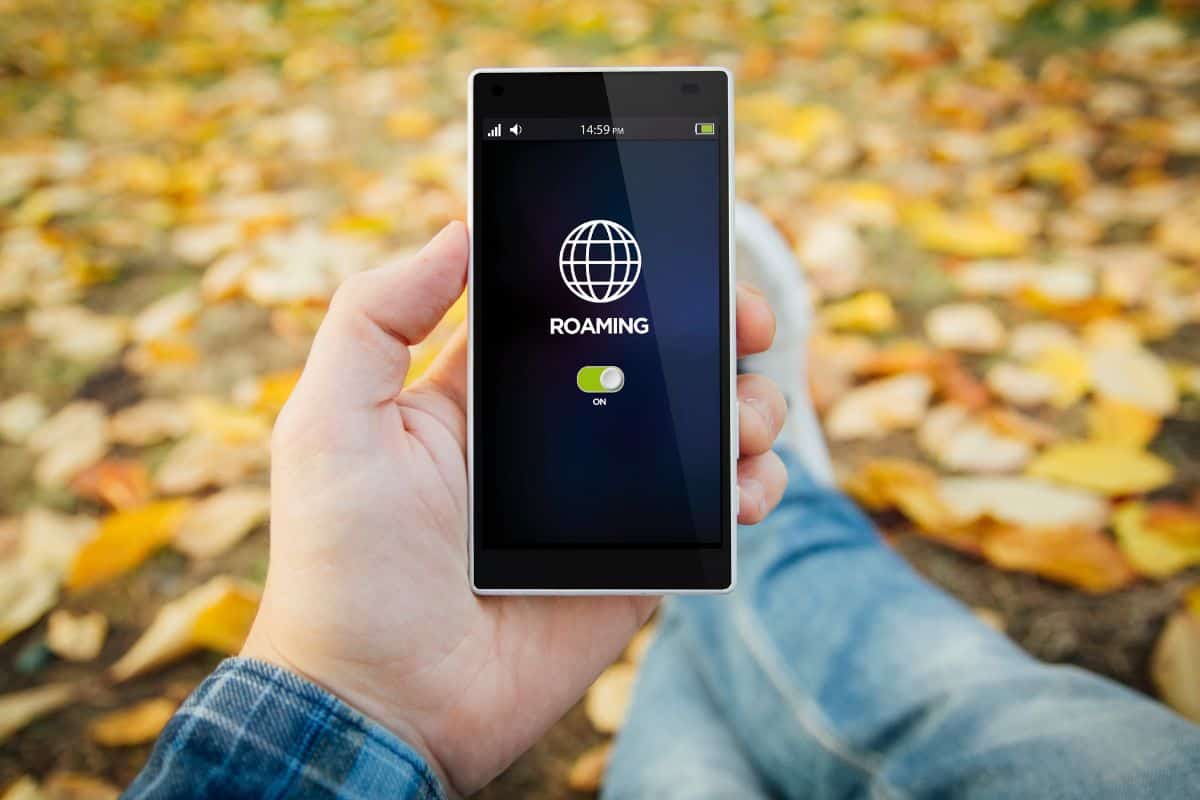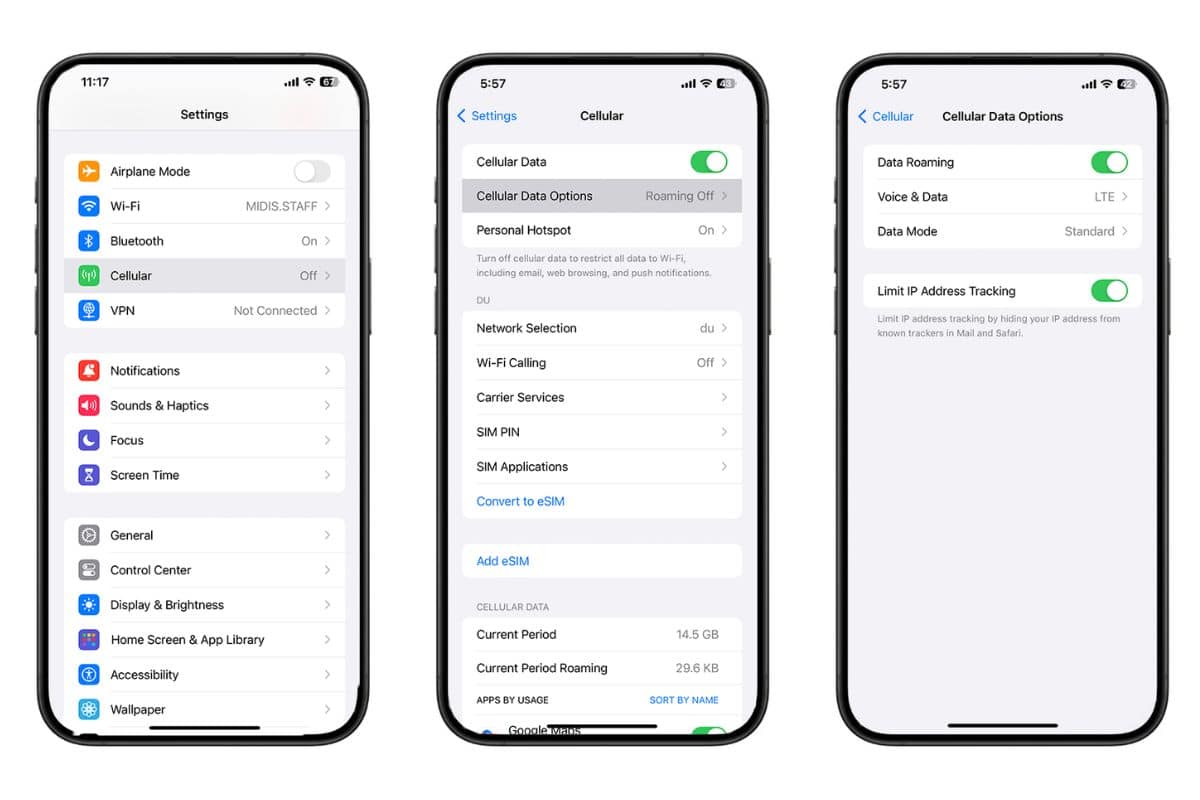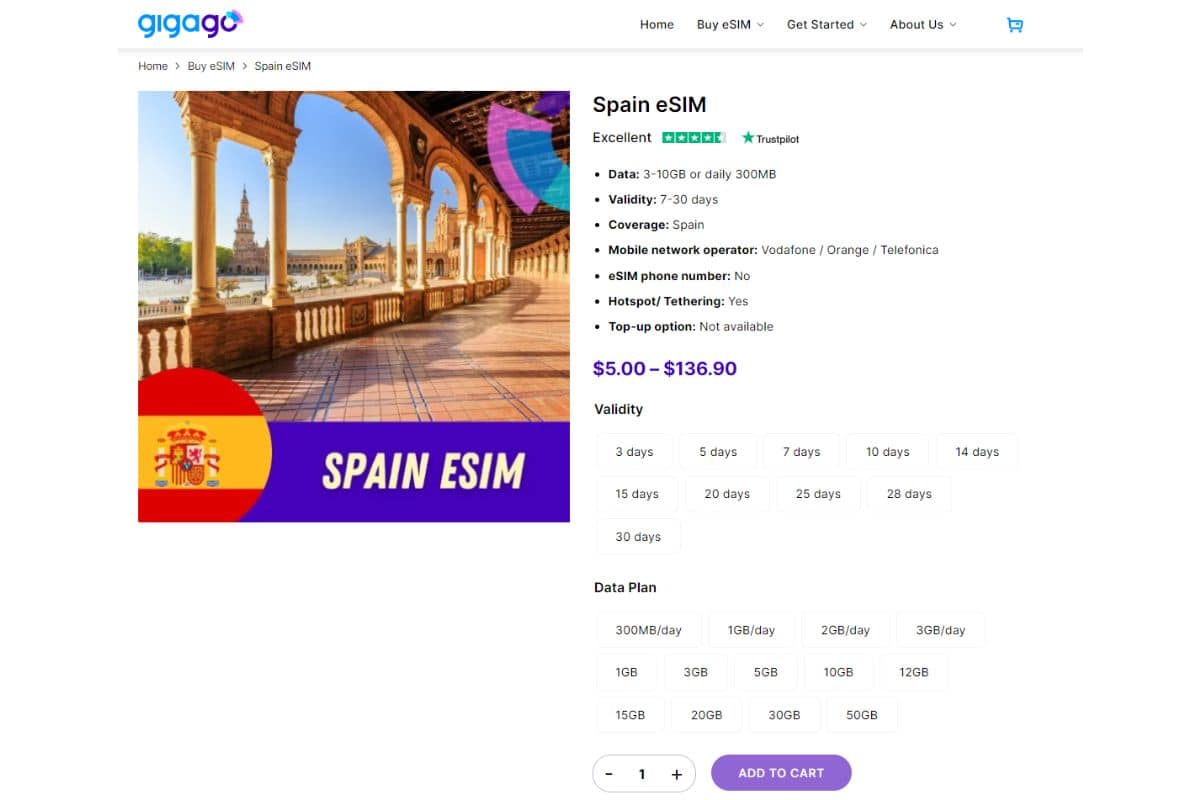Traveling to Spain and wondering if your cell phone will work there or what are the best options to stay connected during your trip? This guide will provide everything you need to know about how to use cell phone in Spain as a traveler. I. Highlights of Phone Compatibility, Frequencies and Networks in Spain Spain […]
Data Roaming in Spain for Travelers: Rates & How to Avoid it
Spain is a popular tourist destination, known for its beautiful beaches, historic cities, and lively culture. However, one thing travelers should be aware of when visiting Spain is phone roaming charges. Getting hit with a huge phone bill after your trip can put a damper on your vacation memories.
The good news is roaming in Spain doesn’t have to be scary or super expensive if you understand how it works and take some simple steps to avoid extra roaming fees. This guide breaks down everything you need to know about cell phone roaming in Spain.

In this article
I. Phone Roaming in Spain – Quick Facts for Tourists
Roaming refers to using your phone on a foreign network when traveling overseas. Instead of connecting to your regular home network, your device connects to a local network in Spain.
Here are some quick things to know:
- Roaming rates in Spain and the EU have dropped in recent years but can still add up, especially for data usage.
- You'll automatically connect to local networks like Movistar, Orange, and Vodafone when roaming in Spain.
- If you don't turn off data roaming, background apps can rack up charges without you realizing.
- Using eSIM data plans, local SIM cards, or WiFi can help reduce or eliminate roaming fees.
Understanding precisely how roaming works in Spain puts the power back in your hands to control fees.
Your phone always needs access to a cellular network to connect for calls, texts, and internet access. Roaming kicks in automatically when your phone’s SIM card latches onto the strongest available local cell network after landing in Spain.
For most travelers, roaming happens without you having to do anything extra. Simply turn on your phone after landing, and your SIM will register and identify access to available Spanish carrier networks like Vodafone, Orange, Movistar or others.
However, know that connecting to foreign networks always incurs extra roaming charges, especially if you start using data while traveling around Spain. We explain more on roaming rates below.
II. Understand about Roaming in Spain – How It Works

To dig deeper, here are some key things all tourists should understand about cell phone roaming works on Spanish networks:
Local Spain Networks & Carriers
The major telecom companies and mobile networks in Spain include:
- Movistar – Spain’s largest mobile network, owned by Telefónica.
- Orange – Second biggest operator, owned by Orange S.A.
- Vodafone Spain – Third largest provider in Spain, owned by Vodafone Group.
- Yoigo – Low-cost Spanish carrier focused mostly on urban areas.
As a traveler, your phone automatically connects through one of these networks while visiting Spain. The roaming agreement and rates will depend on the network(s) your home mobile provider has established contracts and partnerships with in Spain and the EU.
International Roaming Rates & Billing
With international roaming, the foreign network bills your domestic provider when you use services abroad, applying whatever roaming rates and fees they have established, plus taxes and surcharges.
Your home carrier then passes those roaming charges along to your account. Depending on your cell phone plan, roaming fees get lumped into your regular monthly bill or deducted from your regular rate plan balance/credits.
Many new cell plans now offer free (usually limited) international roaming bundled in certain countries. But going over data allowances while traveling still means costly overage fees.
Background Data Drain = Bigger Bills
One common mistake travelers make is forgetting to disable background data usage and automatic app updates when phone roaming internationally. Even with data roaming turned off, phones periodically connect to cell towers and WiFi signals.
Settings, apps, iCloud, etc. in the background generate data traffic most people forget about. And at high roaming rates, a few megabytes here and there means returning home to find extraordinarily high phone bills.
Turning off all cellular data and background app refreshing before traveling prevents bill shock. Alternatively, using eSIM plans or local SIM cards means only paying local rates for Spain.
III. Is Roaming in Spain Expensive?

Historically, roaming rate in Spain and Europe used to be outrageously expensive. However, thanks to EU roaming regulations in recent years, rates have dropped substantially compared to what travelers previously faced.
EU Roaming Rate Caps & Fair Use Limits
Since June 2017, EU roaming regulations guarantee:
- Wholesale Roaming Rate Caps – The maximum rates EU operators can charge one another is capped per gigabyte of roaming data usage.
- Retail Rate Limits – The maximum rate telecom companies can charge customers is €3-€4 per GB (excluding VAT) while roaming in Spain, depending on the currency exchange.
On top of wholesale and retail rate caps, EU roaming regulations also impose “fair use” limits on how much people can roam abroad within bundle allowances. The current fair use limits are:
- At least 2x the data volume of your contracted data package.
- Unlimited minutes/texts for periodic travel abroad.
- 90 cumulative international roaming days per year.
Once a year is up, if your roaming exceeds the fair use amount, regular roaming rates may apply for the remainder of the year.
Average Roaming Rates in Spain
Thanks to EU regulation, Spain roaming is much cheaper than it used to be, with maximum per GB rates around €3 to €12 for pay-as-you-go without an international plan.
But exactly how much you’ll pay out of pocket depends entirely on your cell provider’s specific Spain/EU roaming rates & fees, which come in two forms:
1. Bundled Roaming Rates – Roaming deals as part of monthly cell plans usually charge a daily flat-rate for international usage or a fixed rate per GB used abroad.
2. Pay-Per-Use Rates – Once bundled roaming data is exceeded (or without a bundle), pay-as-you-go per MB/GB roaming rates apply on top of your regular bill for Spain & EU usage.
While rates have dropped, €3-12 per GB can still really add up if you eat through multiple GB checking social media, using Google Maps to navigate around Spain, streaming Netflix or Spotify to pass time while traveling between Spanish cities.
As a tourist to Spain, you can consider other connectivity options like prepaid SIM cards/eSIMs, portable WiFi as alternatives to roaming. Pocket WiFi for Spain travel is useful if you want to share Internet for multiple devices, but it is quite pricey and requires effort to bring along. On the other hand, prepaid SIM cards/eSIMs are more affordable and flexible. Therefore, if your phone is carrier-unlocked and compatible, consider using these options as alternatives to roaming.
IV. How to Activate Roaming Service for Spain in Your Cell Phone?
Activating international roaming services before you travel is a wise safeguard to ensure seamless cell coverage abroad. But it may not be absolutely necessary nowadays when visiting Spain and the EU thanks to roaming regulations guaranteeing fair, reasonable rates for foreign travelers.
Enabling Roaming Mode on iPhone

For iPhones, cellular data roaming is activated by default to allow connectivity internationally when traveling overseas. However, you can check settings to confirm data roaming is enabled:
- Open “Settings”
- Tap on “Cellular” (or “Mobile” on iOS 12 & earlier)
- Ensure “Enable LTE / 4G” and “Data Roaming” are both switched on (green)
And that’s it! As long as Data Roaming is enabled, your iPhone will automatically connect to Spanish cell networks.
But remember rates still apply, so you’ll want to disable cellular data before traveling if you wish to avoid roaming charges entirely while in Spain.
For more details on cellular data roaming options and settings on iPhone and iPad, please visit this Apple support page: https://support.apple.com/en-us/109037
Activating International Roaming on Android
Similarly, data roaming mode is automatically enabled by default on most Android devices running OS 8.0+ as long as you have an active SIM card inserted with mobile data switched on.
If your Android device has an older OS version or you simply want to double check roaming is active before your trip, you can dive into Settings to confirm:
- Open Android’s “Settings” app
- Tap “Connections” or “Network & Internet”
- Select “Mobile network”
- Ensure “Roaming” and “Mobile data” toggles are both enabled
If disabled, tap the switches next to each option to turn international roaming permissions on.
With mobile data and roaming properly configured in settings, Android devices will connect to available Spanish networks automatically when traveling in the country.
Of course, you can always manually disable roaming or mobile data through these same settings at any time to avoid unwanted usage and fees while abroad.
V. How to Avoid Roaming Charges When Traveling to Spain
To review, avoiding excessive roaming fees in Spain involves three main options:
- Turn Off Cellular Data Roaming – Stop background data usage entirely while traveling internationally.
- Use eSIM Data Plans – Local data SIMs prevent roaming fees by paying local rates.
- Connect WiFi Only – Hopping onto free WiFi hotspots prevents roaming data charges altogether.
VI. GIGAGO’s Spain eSIM – An Alternative to Data Roaming in Spain
Another great way to avoid roaming rate rip-offs while visiting Spain is using eSIM data plans. A top provider to consider is GIGAGO, which offers reliable and affordable eSIM plans specifically for Spain.
What is an eSIM?
An “eSIM” or “Embedded SIM” is a digital-only mobile plan stored virtually in compatible smartphones instead of on a physical SIM card. eSIM plans offer pay-as-you-go data packages in over 190 countries without forcing travelers to deal with the hassle of swapping SIM cards constantly while visiting other countries.
Benefits of eSIM Data Plans
Major advantages of eSIM data plans include:
- Avoid expensive roaming fees by paying low local data rates
- Hotspot internet to laptops/tablets with smartphone datasharing
- Seamless connectivity across Spain by mixing & matching plans
- eSIMs are simpler & safer than physical SIM cards
GIGAGO’s Spain eSIM

GIGAGO provides high-quality eSIM plans specifically designed for travelers visiting Spain. Their affordable Spain eSIM includes features like unlimited data usage, hotspot sharing, and reliable coverage throughout the country on the Movistar network.
For Spain, Gigago offers multiple data plan options, starting from 1 GB for 3 days with $ 2.0 . What is great about Gigago’s Spain eSIM is that its plans’ costs are diversifying, varying between $ 2.0 – $ 99.5 . Thus, it does not matter how Internet users you are and how long your trip is in Spain, there is always an option for you with Gigago.
This makes GIGAGO’s eSIM an excellent alternative to expensive data roaming in Spain with your home carrier. Say goodbye to surprise bills – get connected in Spain with stable internet through GIGAGO.
How eSIM Data Plans Eliminate Roaming Fees
Instead of connecting your existing number/SIM card through an international roaming agreement, eSIMs provide separate mobile connectivity through local carrier networks as you move around the country.
This allows travelers to bypass roaming middlemen and pay affordable flat-rate local data prices, saving substantially compared to costly roaming overages charged by regular cell providers.
VII. How to Turn Off Data Roaming When Traveling in Spain
Below we outline step-by-step how to properly disable international cellular data connectivity on both iPhones and Android devices before traveling to completely avoid data roaming usage/fees abroad while visiting Spain.
1. Turn off international roaming on Android When Traveling in Spain
Here is how to turn off data roaming on Android devices:
- Open Settings > Network & internet > Mobile network
- Toggle “Roaming” to the OFF position (gray)
- Return to Settings homepage
- Tap “Connected devices” > “Connection preferences” > “Mobile networks“
- Ensure “Mobile data” switch is also disabled
With mobile data and roaming now fully disabled in settings, your Android smartphone cannot incur any unwanted data usage charges as you travel between areas in Spain.
Remember to re-enable roaming & data when you return!
Hop back into settings to toggle roaming and mobile data switches back ON (green) after returning home. Failing to reactivate could mean missing calls/texts on your number when back!
2. Turn off international roaming on iPhones
Likewise, here is how to completely disable cellular data on iPhones when traveling internationally to Spain:
- Go to Settings > Cellular (or Mobile)
- Tap the switch next to “Enable LTE / 4G” so it turns gray (off position)
- Scroll down and toggle “Data Roaming” to disabled (gray) as well
This prevents iPhones from connecting mobile networks abroad to block unwanted roaming data usage/fees.
Don't forget to re-enable roaming & LTE when home
It's easy to forget small settings tweaks made before traveling. To avoid issues, flip both Data Roaming and Enable LTE back ON in iOS settings when safely home to restore regular iPhone connectivity on home networks.
VIII. FAQs
Can I use my regular SIM card in Spain?
Yes, most modern phones with unlocked SIM slots will work perfectly fine in Spain and automatically connect local networks via roaming when powered on after landing. However, international roaming rates, fees, and overage charges from your provider would apply.
Do I need to notify my phone carrier before traveling to Spain?
Generally no advance notice is required thanks to automatic roaming agreements between international carriers. However, some providers may require contacting support to activate an international plan for reduced roaming rates, or at minimum having a travel notice added to your account to prevent service interruptions abroad. Check with your specific carrier to understand any mobile policies, surcharges, or steps required before visiting Spain.





